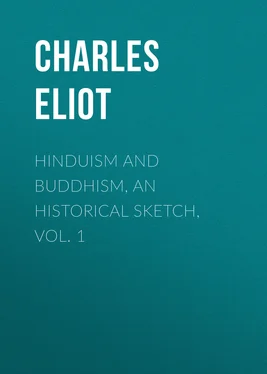Charles Eliot - Hinduism and Buddhism, An Historical Sketch, Vol. 1
Здесь есть возможность читать онлайн «Charles Eliot - Hinduism and Buddhism, An Historical Sketch, Vol. 1» — ознакомительный отрывок электронной книги совершенно бесплатно, а после прочтения отрывка купить полную версию. В некоторых случаях можно слушать аудио, скачать через торрент в формате fb2 и присутствует краткое содержание. Жанр: foreign_religion, Философия, Религиозная литература, foreign_psychology, foreign_antique, foreign_prose, на английском языке. Описание произведения, (предисловие) а так же отзывы посетителей доступны на портале библиотеки ЛибКат.
- Название:Hinduism and Buddhism, An Historical Sketch, Vol. 1
- Автор:
- Жанр:
- Год:неизвестен
- ISBN:нет данных
- Рейтинг книги:5 / 5. Голосов: 1
-
Избранное:Добавить в избранное
- Отзывы:
-
Ваша оценка:
- 100
- 1
- 2
- 3
- 4
- 5
Hinduism and Buddhism, An Historical Sketch, Vol. 1: краткое содержание, описание и аннотация
Предлагаем к чтению аннотацию, описание, краткое содержание или предисловие (зависит от того, что написал сам автор книги «Hinduism and Buddhism, An Historical Sketch, Vol. 1»). Если вы не нашли необходимую информацию о книге — напишите в комментариях, мы постараемся отыскать её.
Hinduism and Buddhism, An Historical Sketch, Vol. 1 — читать онлайн ознакомительный отрывок
Ниже представлен текст книги, разбитый по страницам. Система сохранения места последней прочитанной страницы, позволяет с удобством читать онлайн бесплатно книгу «Hinduism and Buddhism, An Historical Sketch, Vol. 1», без необходимости каждый раз заново искать на чём Вы остановились. Поставьте закладку, и сможете в любой момент перейти на страницу, на которой закончили чтение.
Интервал:
Закладка:
30
According to the Census of 1911.
31
There are curious survivals of paganism in out of the way forms of Christianity. Thus animal sacrifices are not extinct among Armenians and Nestorians. See E.R.E. article "Prayer for the Dead" at the end.
32
The Buddhism of Siam and Burma is similar but in Siam it is a mediæval importation and the early religious history of Burma is still obscure.
33
Although stability is characteristic of the Hinayana its later literature shows a certain movement of thought phases of which are marked by the Questions of Milinda, Buddhaghosa's works and the Abhidhammattha Sangaha.
34
E.g. the way a monastic robe should be worn and the Sîmâ.
35
I believe this to be the orthodox explanation but it is open to many objections.
(1) It is a mere phrase. If to create means to produce something out of nothing, then we have never seen such an act and to ascribe a sudden appearance to such an act is really no explanation. Perhaps an act of imagination or a dream may justly be called a creation, but the relation between a soul and its Creator is not usually regarded as similar to the relation between a mind and its fancies.
(2) The responsibility of God for the evil of the world seems to be greatly increased, if he is directly responsible for every birth of a child in unhappy conditions.
(3) Animals are not supposed to have souls. Therefore the production of an animal's mind is not explained by this theory and it seems to be assumed that such a complex mind ag a dog's can be explained as a function of matter, whereas there is something in a child which cannot be so explained.
(4) If a new immortal soul is created every time a birth takes place, the universe must be receiving incalculably large additions. For some philosophies such an idea is impossible. (See Bradley, Appearance and Reality , p. 502. "The universe is incapable of increase. And to suppose a constant supply of new souls, none of which ever perished, would clearly land us in the end in an insuperable difficulty.") But even if we do not admit that it is impossible, it at least destroys all analogy between the material and spiritual worlds. If all the bodies that ever lived continued to exist separately after death, the congestion would be unthinkable. Is a corresponding congestion in the spiritual world really thinkable?
36
This seems to be the view of the Chândogya Up. VI. 12. As the whole world is a manifestation ol Brahman, so is the great banyan tree a manifestation of the subtle essence which is also present in its minute seeds.
37
The Brihad Ar. Up. knows of samsâra and karma but as matters of deep philosophy and not for the vulgar: but in the Buddhist Pitakas they are assumed as universally accepted. The doctrine must therefore have been popularized after the composition of the Upanishad. But some allowance must be made for the fact that the Upanishads and the earliest versions of the Buddhist Suttas were produced in different parts of India.
38
Yet many instances are quoted from Celtic and Teutonic folklore to the effect that birds and butterflies are human souls, and Caesar's remarks about the Druids may not be wholly wrong.
39
Several other Europeans of eminence have let their minds play with the ideas of metempsychosis, pre-existence and karma, as for instance Giordano Bruno, Swedenborg, Goethe, Lessing, Lavater, Herder, Schopenhauer, Ibsen, von Helmont, Lichtenberg and in England such different spirits as Hume and Wordsworth. It would appear that towards the end of the eighteenth century these ideas were popular in some literary circles on the continent. See Bertholet, The Transmigration of Souls , pp. 111 ff. Recently Professor McTaggart has argued in favour of the doctrine with great lucidity and persuasiveness. Huxley too did not think it absurd. See his Romanes Lecture, Evolution and Ethics, Collected Essays , vol. IX. p. 61. As Deussen observes, Kant's argument which bases immortality on the realization of the moral law, attainable only by an infinite process of approximation, points to transmigration rather than immortality in the usual sense.
40
The chemical elements are hardly an exception. Apparently they have no beginning and no end but there is reason to suspect that they have both.
41
I know well-authenticated cases of Burmese and Indians thinking that the soul of a dead child had passed into an animal.
42
Or again, when I wake up in the morning I am conscious of my identity because innumerable circumstances remind me of the previous day. But if I wake up suddenly in the night with a toothache which leaves room for no thought or feeling except the feeling of pain, is the fact that I experience the pain in any way lessened if for the moment I do not know who or where I am?
43
I believe that a French savant, Colonel Rochas, has investigated in a scientific spirit cases in which hypnotized subjects profess to remember their former births and found that these recollections are as clear and coherent as any revelations about another world which have been made by Mrs Piper or other mediums. But I have not been able to obtain any of Col. Rochas's writings.
44
I use the word soul merely for simplicity, but Buddhists and others might demur to this phraseology.
45
But for a contrary view see Reincarnation, the Hope of the World by Irving S. Cooper. Even the Brihad Aran. Upan. (IV. 4. 3. 4) speaks of new births as new and more beautiful shapes which the soul fashions for itself as a goldsmith works a piece of gold.
46
The increase of the human population of this planet does not seem to me a serious argument against the doctrine of rebirth for animals, and the denizens of other worlds may be supplying an increasing number of souls competent to live as human beings.
47
Perhaps Russians in this as in many other matters think somewhat differently from other Europeans.
48
Varieties of Religious Experience , p. 427. The chapter contains many striking instances of these experiences, collected mostly in the west.
49
Compare St Teresa's Orison of Union , W. James, l.c. p. 408.
50
Indian devotees understand how either Śiva or Krishna is all in all, and thus too St Teresa understood the mystery of the Trinity. See W. James, l.c. p. 411.
51
Turîya or caturtha.
52
Indians were well aware even in early times that such a state might be regarded as equivalent to annihilation. Br. Ar. Up. II. 4. 13; Chând. Up. VIII. ii. 1.
53
The idea is not wholly strange to European philosophy. See the passage from the Phaedo quoted by Sir Alfred Lyall. "Thought is best when the mind is gathered into herself and none of these things trouble her—neither sounds nor sights nor pain nor any pleasure—when she has as little as possible to do with the body and has no bodily sense or feeling, but is aspiring after being."
54
Mr Bradley (Appearance and Reality , p. 498) says "Spirit is a unity of the manifold in which the externality of the manifold has utterly ceased." This seems to me one of the cases in which Mr Bradley's thought shows an interesting affinity to Indian thought.
Читать дальшеИнтервал:
Закладка:
Похожие книги на «Hinduism and Buddhism, An Historical Sketch, Vol. 1»
Представляем Вашему вниманию похожие книги на «Hinduism and Buddhism, An Historical Sketch, Vol. 1» списком для выбора. Мы отобрали схожую по названию и смыслу литературу в надежде предоставить читателям больше вариантов отыскать новые, интересные, ещё непрочитанные произведения.
Обсуждение, отзывы о книге «Hinduism and Buddhism, An Historical Sketch, Vol. 1» и просто собственные мнения читателей. Оставьте ваши комментарии, напишите, что Вы думаете о произведении, его смысле или главных героях. Укажите что конкретно понравилось, а что нет, и почему Вы так считаете.












